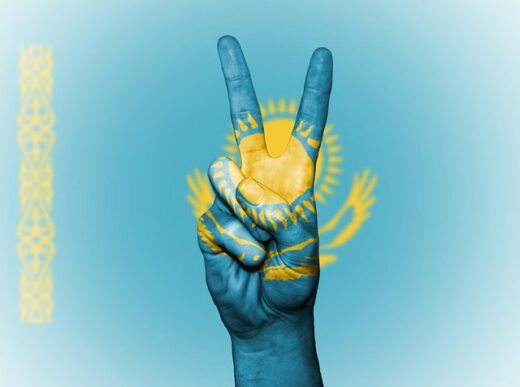By: Orhan Medaev, Kazakhstan Oil Gas Monitor; Kanat Shakut, Almaty (reprinted) & Vivian Salama Wallstreet Journal Oil & Gas Reporter Reporting (reprinted)
The Biden administration is courting Kazakhstan, Central Asia’s oil and gas-rich ethnically diverse country. As Vivian Salama reports, the U.S. is expanding its efforts to prevent Russia from circumventing Western sanctions while providing an opportunity for those countries to ease their reliance on Russia, by expanding investment and diplomacy in the region.

U.S. Secretary of State Antony Blinken made a visit to Eurasia with stops in Kazakhstan and Uzbekistan. He met officials from Kazakhstan, Kyrgyzstan, Tajikistan, Turkmenistan, and Uzbekistan, a bloc that together with the U.S. is known as the C5+1. Yet, analysts maintain that the focus of the U.S. is to particularly build closer ties with the Kazakhs; they have made major reforms in their rule of law and have excoriated kleptocrats, signaling an end to the former Soviet-style corruption. For Western investors the prize in Kazakhstan is big oil and new major discoveries that can prove to be the solution to the impending oil shortage. Recently, there have been several such findings. Global oil prices have been picking up recently. Taxes levied from the oil and gas industry make up nearly half of Kazakhstan’s state budget imbuing Kazakhstan with oil wealth.

Western Kazakhstan’s oil-rich Mangystau region announced recently the discovery of the largest reservoir of hydrocarbons in over 30 years of the country’s post-independence history. The field, where the exploration well showed substantial gushes of oil, is under development by a local company called Meridian Petroleum, the Mangystau provincial government said. The oil at the field appears to be low in sulfurous content, which could potentially make it easier to process and transport. Mangistau province accounts for 25% of all oil and condensate production in Kazakhstan or 18mn tons of oil and 3bn cubic meters of natural gas per annum.
South Kazakhstan’s ARIS Region promises another major oil and gas discovery. Darby Energy, Inc., an independent oil and gas exploration firm, through subsidiaries, works licenses to explore hydrocarbons in the region. One of its fields (originally licensed in 2005), recently, with a change in laws and management structure of the licensee, has availed it of opportunities to secure license extensions.
The U.S.-based exploration firm plans to prospect and produce in the ARIS site. The concession license has been granted for an extendable 25-year term. The ARIS territories cover approximately 22,000 square kilometers in South Kazakhstan’s Kizilordinskoy Regions.
Initial geological studies have been completed that show the potential of locating extraordinary amounts of recoverable oil and gas products in the Aris fields. The studies and initial exploratory drilling have proven the existence of substantial salt structures within the licensed territories. Limited seismic testing has already identified numerous bright spots in association with the salt structures.
The licensees intend to undertake further geological testing, conduct exploratory drilling and secure joint venture partners among major oil and gas players already in the region. The South Kazakhstan region contains about 2 million people. Natural gas is currently delivered to the region from Uzbekistan, with the local supply being subject to shortages. The infrastructure to deliver natural gas locally is in place and the demand for locally produced gas appears to be robust. According to geologist Dan Seamount, the potential in the ARIS fields is billions of barrels of oil equivalent to the in sub-salt reservoirs greater than 15000 100mmboe to 1000mmboe in shallower salt anticlines. There are at least 7 salt domes that look similar and the same size as Spindletop oil found in East Texas, which produces more than 150mmbo, explains Commissioner Seamount. Seamount is the longest-serving Commissioner in the Alaska Oil and Gas Conservation Commission’s history. He served as a senior geologist for Unocal; and prior to that, for Marathon Oil and Chevron. His 29 years of experience in the oil and gas industry involved oil, gas, and geothermal exploration and development in California, the Rocky Mountains, the mid-continent, and Alaska. He holds bachelor’s and master’s degrees in Geology from the University of California.
The oil and gas industry is the basis of Kazakhstan’s economy, and the current trend of higher oil prices has had a significant positive impact not only on the region but also on the industry. The new Kazakhstan leadership has improved the country’s investment policy and introduced changes to legislation that make Kazakhstan more advantageous for foreign investment.
National Company JSC (KazMunayGas), Chevron Corporation, Karachaganak Petroleum Operating B.V., PJSC Gazprom, PJSC Lukoil Oil Company are just some of the major oil companies operating in the Eurasian republic. Today the following European companies are engaged in oil production at various oil fields in the Kazakhstan territory: Italian Eni (Agip – a commercial brand of the company), (Karashyganak, Kashagan), French Total (Kashagan), German Royal Dutch Shell (Kashagan), British British Gas (Karashyganak), Spanish Repsol YPF (South Zhambai), Romanian Petrom (Tasbulat, Aktas, Turkmenistan), Danish Maersk Oil (Dunga).

Chinese oil companies have been operating in the Kazakhstani market for 18 years. For the first time, the Chinese government has received full access to the strategic area of the Kazakh oil and gas industry, in September 1997. CNPC (China National Petroleum Corporation) acquired 60.33% of the shares of “Aktobemunaigas” JSC, one of the largest oil companies in Kazakhstan. In 2001, the company also acquired 50% of the shares of Buzachi Operating Ltd (North Buzachi), and in 2006 – PetroKazakhstan. As a whole, the share of these companies (“Kazakhoil-Aktobe” is also owned by Chinese investors) accounted for 97% of produced crude oil in the Aktobe oblast. Another Chinese company CITIC acquired 50% of shares of Karazhanbasmunai (Karazhanbas).
Japan National Oil Corporation (JNOC) has been trying to establish relationships with the Kazakh oil sector since 2002. Japan is very interested in Kazakhstan’s oil. Even then, the Japanese company Impex (an International Oil Company with 50% owned by Japan National Oil Corporation) owned 8.3% of “Agip KCO” and participated in the North Caspian exploration project. Today the company is engaged in the Kashagan field. Other Asian investors in oil and gas are India’s Mittal Investments (Karakuduk, North Buzachi, South Zhambay, Satpayev), India’s ONGC Videsh Ltd (Satpayev), Turkmen Kazakhturkmunai (Saztyube, Yelemes).
Still, American oil companies (joint with European) accounted for 45% of the total shares in the oil market in Kazakhstan since 2012. As a U.S. ally in the region, Kazakhstan is destined to see more Western investors, positioning it as an alternative to Russian oil.















